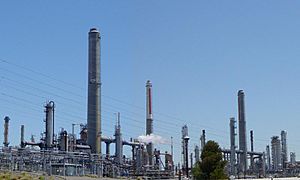Hydrocarbon facts for kids
A hydrocarbon is a special kind of chemical compound. It's made up of just two types of tiny building blocks: hydrogen atoms and carbon atoms.
You can find hydrocarbons in things like crude oil. They are separated into different groups using a process called fractional distillation. This process helps sort them based on their properties. Hydrogen and carbon atoms in hydrocarbons are joined together in a way that makes them "water-fearing" or hydrophobic. This means they don't mix well with water.
Contents
What are Hydrocarbon Families?
Hydrocarbons are sorted into different "families" or groups. These groups are called "homologous series". There are five main families of hydrocarbons.
Hydrocarbons in the same family have a similar basic formula. They also act in similar ways chemically. Their physical properties, like boiling points, also follow similar patterns. This way of grouping them was agreed upon in 1892 by chemists meeting in Geneva.
Alkanes: Simple Hydrocarbons
Alkanes are the most basic type of hydrocarbons. Their general formula is CnH2n+2. This means if you know the number of carbon atoms (n), you can figure out the number of hydrogen atoms.
| Alkane Name | Formula |
|---|---|
| Methane | CH4 |
| Ethane | C2H6 |
| Propane | C3H8 |
| Butane | C4H10 |
| Pentane | C5H12 |
| Hexane | C6H14 |
| Heptane | C7H16 |
| Octane | C8H18 |
| Nonane | C9H20 |
| Decane | C10H22 |
Alkenes: With a Double Bond
Alkenes are a lot like alkanes. The big difference is that alkenes have at least one double bond between two carbon atoms. Their general formula is CnH2n.
| Alkene Name | Formula |
|---|---|
| Ethene | C2H4 |
| Propene | C3H6 |
| Butene | C4H8 |
| Pentene | C5H10 |
| Hexene | C6H12 |
| Heptene | C7H14 |
| Octene | C8H16 |
| Nonene | C9H18 |
| Decene | C10H20 |
You won't find a "Methene." This is because alkenes need a carbon-carbon double bond, and methane only has one carbon atom.
Alkynes: With a Triple Bond
Alkynes are hydrocarbons that have a triple bond between two carbon atoms. Their general formula is CnH2n-2.
| Alkyne Name | Formula |
|---|---|
| Ethyne (Acetylene) | C2H2 |
| Propyne | C3H4 |
| Butyne | C4H6 |
| Pentyne | C5H8 |
| Hexyne | C6H10 |
| Heptyne | C7H12 |
| Octyne | C8H14 |
| Nonyne | C9H16 |
| Decyne | C10H18 |
Just like with alkenes, there's no "Methyne" because it needs at least two carbon atoms to form a triple bond.
Cycloalkanes: Carbon Rings
Cycloalkanes are a special type of hydrocarbon where the carbon atoms form a ring shape. They have the same general formula as alkenes (CnH2n). However, they don't have any carbon-carbon double bonds. Instead, their carbons are linked in a circle.
| Cycloalkane Name | Formula |
|---|---|
| Cyclopropane | C3H6 |
| Cyclobutane | C4H8 |
| Cyclopentane | C5H10 |
| Cyclohexane | C6H12 |
| Cycloheptane | C7H14 |
| Cyclooctane | C8H16 |
| Cyclononane | C9H18 |
| Cyclodecane | C10H20 |
Methane and ethene don't have cycloalkane versions because they only have one or two carbon atoms, which can't form a ring. You need at least three carbon atoms to make a ring.
Alkadiene: Two Double Bonds
Alkadienes are hydrocarbons that have two carbon-carbon double bonds. Their general formula is CnH2n-2. They are similar in formula to alkynes, but their structure is different because they have two double bonds instead of one triple bond.
Aromatic Hydrocarbons: Flat Rings
Aromatic hydrocarbons are special organic molecules that form flat, ring-shaped structures. The simplest ones are benzene and indole.
These molecules can have:
- One ring, like benzene. These are called heterocyclic.
- Two rings, like naphthalene (which is found in mothballs). These are called bicyclic.
- Many rings, like anthracene (used as a red dye). These are called polycyclic.
Their general formula is CnH2n-6, where 'n' is a number that is 6 or greater.
Images for kids
-
A natural oil spring in Korňa, Slovakia.
See also
 In Spanish: Hidrocarburo para niños
In Spanish: Hidrocarburo para niños




